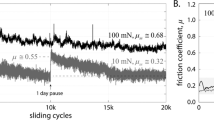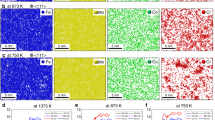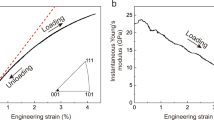Abstract
Since 1932 it has been known that a number of ordered alloys show an unusual kind of deformation behaviour1,2,3. These alloys (including Au–Cd, Au–Cu–Zn, Cu–Zn–Al, Cu–Al–Ni)4,5,6,7,8, after being aged for some time in a martensitic state (the low-symmetry phase of a diffusionless transformation), can be deformed like a soft and pseudo-elastic rubber (with a recoverable strain as large as a few per cent). Accompanying martensite ageing is the development of martensite stabilization9 (increase in the temperature of reverse transformation to the parent state), the avoidance of which is important in actuator applications of the shape-memory effect29, (which these alloys also generally exhibit. The origin of this rubber-like behaviour and of the ageing effect has remained unclear10,11,12,13,14,15,16,17. Here we show that this behaviour does not involve a change in the degree of long-range order, but is instead due to an atomic rearrangement within the same sublattice of the imperfectly ordered alloy during martensite ageing. This process is driven by a general tendency for the equilibrium symmetry of the short-range order configuration of lattice imperfections to conform to the symmetry of the lattice. This principle not only explains all the observed aspects of the rubber-like behaviour and the ageing effect in both ordered and disordered alloys, but may also further our understanding of some diffusion phenomena in other crystalline materials.
This is a preview of subscription content, access via your institution
Access options
Subscribe to this journal
Receive 51 print issues and online access
$199.00 per year
only $3.90 per issue
Buy this article
- Purchase on Springer Link
- Instant access to full article PDF
Prices may be subject to local taxes which are calculated during checkout



Similar content being viewed by others
References
Otsuka, K. & Wayman, C. M. in Review on the Deformation Behavior of Materials Vol. 2(ed. Feltham, P.) 81–172 (Freund, Tel Aviv, Israel, (1977)).
Christian, J. W. Deformation by moving interface. Metall. Trans. 13A, 509–538 (1982).
Cahn, R. W. Metallic rubber bounces back. Nature 374, 120–121 (1995).
Ölander, A. An electrochemical investigation of solid cadmium–gold alloys. J. Am. Chem. Soc. 56, 3819–3833 (1932).
Nakajima, Y., Aoki, S., Otsuka, K. & Ohba, T. The rubber-like behavior of ζ′ (trigonal) martensite in Au-49.5 to 50.0 at% Cd alloys. Mater. Lett. 21, 271–274 (1994).
Miura, S., Maeda, S. & Nakanishi, N. Pseudoelasticity in Au–Cu–Zn thermoelastic martensite. Phil. Mag. 30, 565–581 (1974).
Rapacioli, R., Chandrasekaran, M. & Ahlers, M. in Shape Memory Effects in Alloys (ed. Perkins, J.) 365–378 (Plenum, New York, (1975)).
Sakamoto, H., Otsuka, K. & Shimizu, K. Rubber-like behavior in a Cu–Al–Ni alloy. Scripta Metall. 11, 607–611 (1977).
Tadaki, K., Otsuka, K. & Shimizu, K. Shape memory alloys. Annu. Rev. Mater. Sci. 18, 25–45 (1988).
Birnbaum, H. K. & Read, T. A. Stress induced twin boundary motion in AuCd β′ and β″ alloys. Trans. AIME 218, 662–669 (1960).
Lieberman, D. S., Schmetling, M. A. & Karz, R. S. in Shape Memory Effects in Alloys (ed. Perkins, J.) 203–244 (Plenum, New York, (1975)).
Zangwill, A. & Bruinsma, R. Origin of martensitic pseudoelasticity. Phys. Rev. Lett. 53, 1073–1076 (1984).
Abu Arab, A. & Ahlers, M. The stabilization of martensite in Cu–Zn–Al alloys. Acta Metall. 36, 2627–2638 (1988).
Tadaki, T., Okazaki, H., Nakata, Y. & Shimizu, K. Atomic configuration studies by ALCHEMI and X-ray diffraction of a stabilized M18R martensite in a β phase Cu–Au–Zn alloy. Mater. Trans. Jpn Inst. of Metals 31, 941–947 (1990).
Ahlers, M., Barcelo, G. & Rapacioli, R. Amodel for the rubber-like behavior in Cu–Zn–Al martensites. Scripta Metall. 12, 1075–1078 (1978).
Marukawa, K. & Tsuchiya, K. Short-range ordering as the cause of the rubber-like behavior in alloy martensites. Scripta Metall. 32, 77–82 (1995).
Suzuki, T., Tonokawa, T. & Ohba, T. Role of short-range order in martensitic transformation. J. Phys. III 5(C8), 1065–1070 (1995).
Cahn, J. W. Thermodynamic and structural changes in deformation twinning of alloys. Acta Metall. 25, 1021–1026 (1977).
Barcelo, G., Rapacioli, R. & Ahlers, M. The rubber effect in Cu–Zn–Al martensite. Scripta Metall. 12, 1069–1074 (1978).
Murakami, Y., Nakajima, Y., Otsuka, K. & Ohba, T. Effect of existing twin boundaries in martensite on the rubber-like behavior and aging effect in Au–Cd alloys. J. Phys. III 5(C8), 1071–1076 (1995).
Ohba, T., Otsuka, K. & Sasaki, S. Study of rubber-like behavior in a Au–47.5 at% Cd alloy by synchrotron-orbital radiation. Mater. Sci. Forum 56–58;, 317–322 (1990).
Ohba, T., Finlayson, T. & Otsuka, K. Diffraction profile change in Au–Cu–Zn alloy with aging. J. Phys. III 5(C8) 1083–1086 (1995).
Hagel, W. C. in Intermetallic Compounds (ed. Westbrook, J. H.) 377–404 (Wiley, New York, (1967)).
Christian, J. W. The Theory of Transformations in Metals and Alloys (Pergamon, Oxford, (1965)).
Burkart, M. W. & Read, T. A. Diffusionless phase change in the indium–thallium system. Trans. AIME 197, 1516–1523 (1953).
Basinski, Z. S. & Christian, J. W. Cystallography of deformation by twin boundary movement in indium–thallium alloys. Acta Metall. 2, 101–116 (1954).
Zener, C. Stress induced preferential orientation of pairs of solute atoms in metallic solid solution. Phys. Rev. 71, 34–38 (1947).
Birkenbeil, H. J. & Cahn, R. W. Induced magnetic anisotropy created by magnetic and stress annealing of iron–aluminium alloys. Proc. Phys. Soc. 79, 831–847 (1962).
Miyazaki, S. & Otsuka, K. in Shape Memory Alloys (ed. Funakubo, H.) 116–175 (Gordon and Breach, New York, (1987).
Acknowledgements
We thank T. Suzuki, T. Ohba, H. Horiuchi, M. Kogachi and Y. Murakami for helpful discussions and critical reading the manuscript; T. Ishii for technical assistance; and T. Ohba for allowing us to use his published diffraction data. The work was supported by a Grant-in-Aid for Scientific Research on Priority Area of Phase Transformations (1997–1999) from the Ministry of Education, Science and Culture of Japan. X.R. is a recipient of a JSPS Fellowship.
Author information
Authors and Affiliations
Corresponding author
Rights and permissions
About this article
Cite this article
Ren, X., Otsuka, K. Origin of rubber-like behaviour in metal alloys. Nature 389, 579–582 (1997). https://doi.org/10.1038/39277
Received:
Accepted:
Issue Date:
DOI: https://doi.org/10.1038/39277
This article is cited by
-
Superelasticity Induced by a Strain Gradient
Shape Memory and Superelasticity (2023)
-
Magnetic field-induced rubber-like behavior in Ni-Mn-Ga particles/polymer composite
Scientific Reports (2019)
-
The low frequency relaxor properties of ferroelectric PZT-4 studied by DMA
Journal of Materials Science: Materials in Electronics (2019)
-
In Situ Neutron Diffraction Analyzing Stress-Induced Phase Transformation and Martensite Elasticity in [001]-Oriented Co49Ni21Ga30 Shape Memory Alloy Single Crystals
Shape Memory and Superelasticity (2018)
-
Structural and electronic transformation pathways in morphotropic BiFeO3
Scientific Reports (2016)
Comments
By submitting a comment you agree to abide by our Terms and Community Guidelines. If you find something abusive or that does not comply with our terms or guidelines please flag it as inappropriate.



